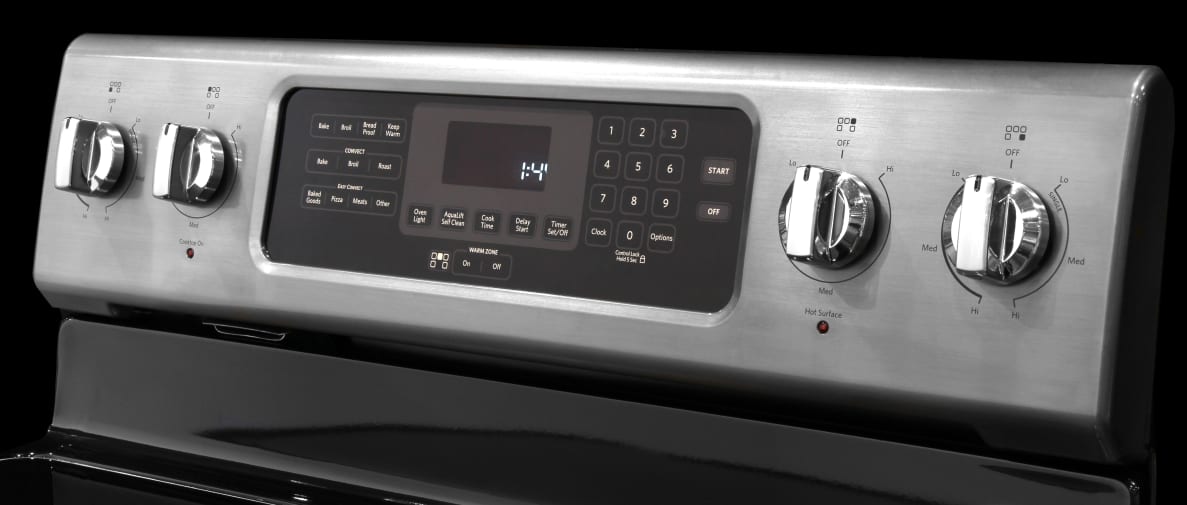It has all the standard settings, with enough extras (dual-ring burners, a rangetop melt setting) to keep it from being too basic, but no so many that it's extravagant. If Goldilocks was range shopping and not in a particularly extravagant mood, we’d imagine she’d declare this one “just right.”
Design & Usability
Just the basics
To be frank, we’re glad this range is destined to do exciting things like cooking steak and baking pies, because the appliance alone won't stand out in your kitchen. The stainless steel body and black rangetop follow a popular—but unremarkable—color pattern. It will fit in with your other stainless steel appliances without drawing the eye. It’s not ugly, but nobody will confuse it for a professional product.
{{ photo_gallery name="Design and Usability" }}
Rangetop controls are pretty standard—knobs on the backsplash require you to reach across a hot cooking surface in order to adjust temperature. Digital controls are located on the backsplash as well, and are devoid of any special settings beyond broil, convection, and the low-heat, water-based "AquaLift" self-clean cycle.
The rangetop boasts five radiant elements, including two dual-ring burners, a melt element, and a rear central warm zone. The 6.2 cubic-foot oven will fit a turkey or a few racks of cookies, and a storage drawer at the base of the range has space for pots and pans.
Rangetop
Melt, simmer, sear, and everything in between.
We’d be hard-pressed to find anything negative to say about the KERS202BSS’s rangetop. The front dual-ring burners each boiled six cups of water in less than seven minutes, which really cuts down on the wait time for eager pasta enthusiasts. Other burners took longer than ten minutes, but most people don’t need to boil more than two pots at once.

The rangetop was able to reach a wide range of temperatures.
Most of the burners received fantastic scores in our temperature tests, with all but one reaching maximum temperatures between 613°F and 757°F. The inner ring of the left front burner was the only outlier, unable to raise the heat above 480°F. The rangetop also proved superior at low temp cooking, with burners reaching their lows between 92°F and 153°F. The 92°F lowest temp came from the left rear burner’s melt setting, which should be useful when melting butter or chocolate.
With relatively few quirks and an outstanding performance, it would be difficult for an electric rangetop to beat the KERS202BSS’s scores.
Oven, Broiler, & Convection
A good oven—just stick to convection
A solid 11-minute preheat started off our oven testing on a reasonable—but not phenomenal—note. The broiler, on the other hand, flunked our testing, proving unable to reach a hot enough temperature during our 16-minute test. Luckily the KERS202BSS also has a convection broil setting, which fared much better in our tests. With that in mind, we’d recommend that users ignore the regular broil setting in favor of the convection broil.

The oven cavity has a capacity of 6.2 cubic feet.
Our real-world baking tests were a mixed bag. Cakes and cookies emerged from the oven with dark bottoms and light tops, indicating a lack of evenness in heat throughout the cavity. However, we weren’t too concerned about this variation in doneness, as it seemed to happen almost completely uniformly to each individual cookie and cake. Sometimes that's just how the cookie crumbles. We’d recommend using parchment paper or a light-colored pan to try to reduce the darkness of the bottoms during baking.
When it came to temperature testing, we found that the convection setting did exactly what it was supposed to, improving the oven’s ability to cling steadily to target temperatures. As far as we’re concerned, there should be no reason to bother using another setting.
Conclusion
Capable, but not fancy.
This is a good range from a higher-end brand that sells for a reasonable price. It’s not particularly fancy or flashy, but it should be up for almost any dish you want to throw at it. As with any range, it’s important to take the time to get to know its quirks, but we're happy that the KERS202BSS gets out of the way and lets you do the cooking.
From the Lab
We put our ranges through a series of rigorous tests to measure everything from how quickly they boil water to how evenly they bake cakes. The KitchenAid KERS202BSS’s performance had some variability, but scored very well overall.
Oven & Broiler Performance
The most vital part of our oven testing is when we roll up our sleeves and see how the oven handles baking real food. In our cookie tests, we bake sugar cookies in the oven and then measure the difference in browning between the cookie tops and bottoms, as well as the difference in browning from one cookie to another. In our cake tests, we take the same types of measurements as we do in our cookie tests, while also noting the degree to which different spots in the same cake vary in doneness, and ensure that our cakes rise evenly.
The KERS202BSS handled one aspect of baking extremely well, but struggled with another. The cakes and cookies we baked in the oven emerged with dark bottoms and light tops. This variation in doneness from top to bottom for both cakes and cookies, as well as the lack of even browning between one spot on a cake and another, was disappointing.
{{ photo_gallery name="Baking Tests" }}
However, to the oven’s credit, the top-to-bottom variation was almost identical for each individual cookie we baked, as well as for each cake. This means that even though it seems the oven doesn’t have perfect heat regulation, it should be entirely workable. We’d recommend using light-colored pans or lining the pans with parchment paper to combat this issue, or perhaps even baking on a higher rack. (We used the manufacturer's recommendations.) As always, we’d also recommend that you check on your food toward the end of the bake time to make sure your food isn’t over-browning.
The broiler flunked our testing, as it proved unable to reach a temperature of 610°F in 16 minutes. The convection broil setting, however, fared much better, reaching 607°F in about 7 minutes. In short, the only broiling this oven does is convection broiling. So long as you use that setting, your broiling needs should be met.
The oven preheat time was a solid 11 minutes for both regular and convection settings, and it’s worth noting that we found the convection setting to be superior at temperature regulation. We’d recommend cooking with convection whenever possible.
Rangetop Performance
We have no complaints with this fantastic rangetop, which earned extremely high scores in both boiling and temperature tests.
In our boiling test we track the amount of time it takes each cooking zone to boil water. The outer ring of the front left burner was the fastest, boiling six cups in an incredibly speedy 3 minutes 35 seconds. The runner-up spot was taken by the outer ring of the front right burner, which took just under 7 minutes to bring 6 cups to a boil. The inner ring of the front left burner took longer, but by less than a minute. These options should allow you to boil two pots at once, and fairly quickly at that. The rear burners did take longer (more than 10 minutes), so we’d recommend you use the front burners for boiling whenever possible.

The outer rings of the front burners were extremely quick to boil water.
We also test rangetops for their ability to reach high and low temperatures. All burners excluding the front left burner’s inner ring impressed us with sizzling highs, with the front right outer ring and the left rear burners reaching temperatures above 730°F. The remaining burners were able to hit high temperatures between 600°F and 700°F, except for the front left burner’s inner ring, which failed to pass 480°F. Not a problem when every other burner is in steak-searing shape.
Low temperatures were also very good, The lowest temp came in at 92°F, thanks to the left rear burner’s melt setting. Most of the other cooking zones hit their lowest points around 100°F, while not one rose above 160°F. Our verdict? Melt all the chocolate and butter you want! Simmer soups! Cook sauces! This rangetop can handle it.

The burners were able to reach both high and low temperatures.
Meet the tester
Kori began her journalism career as a teenage fashion blogger and has enjoyed covering a wide variety of topics ever since. In her spare time, she’s an amateur poet, avid reader, and gluten-free cake baker extraordinaire.
Checking our work.
Our team is here to help you buy the best stuff and love what you own. Our writers, editors, and experts obsess over the products we cover to make sure you're confident and satisfied. Have a different opinion about something we recommend? Email us and we'll compare notes.
Shoot us an email

